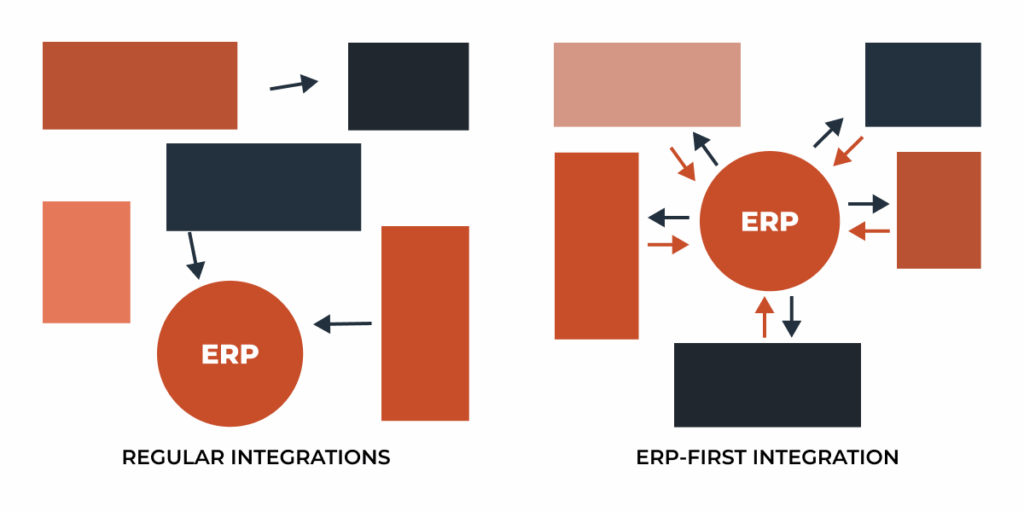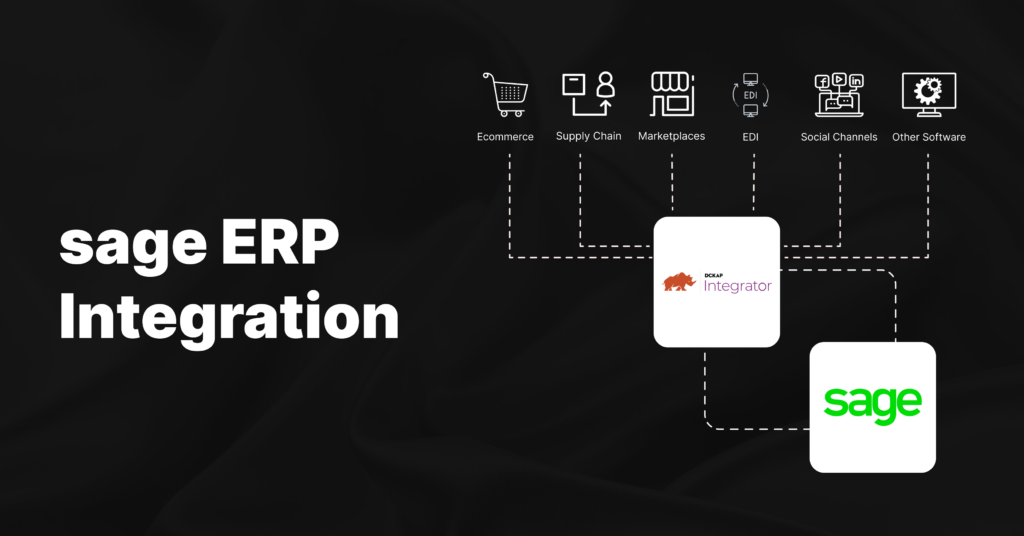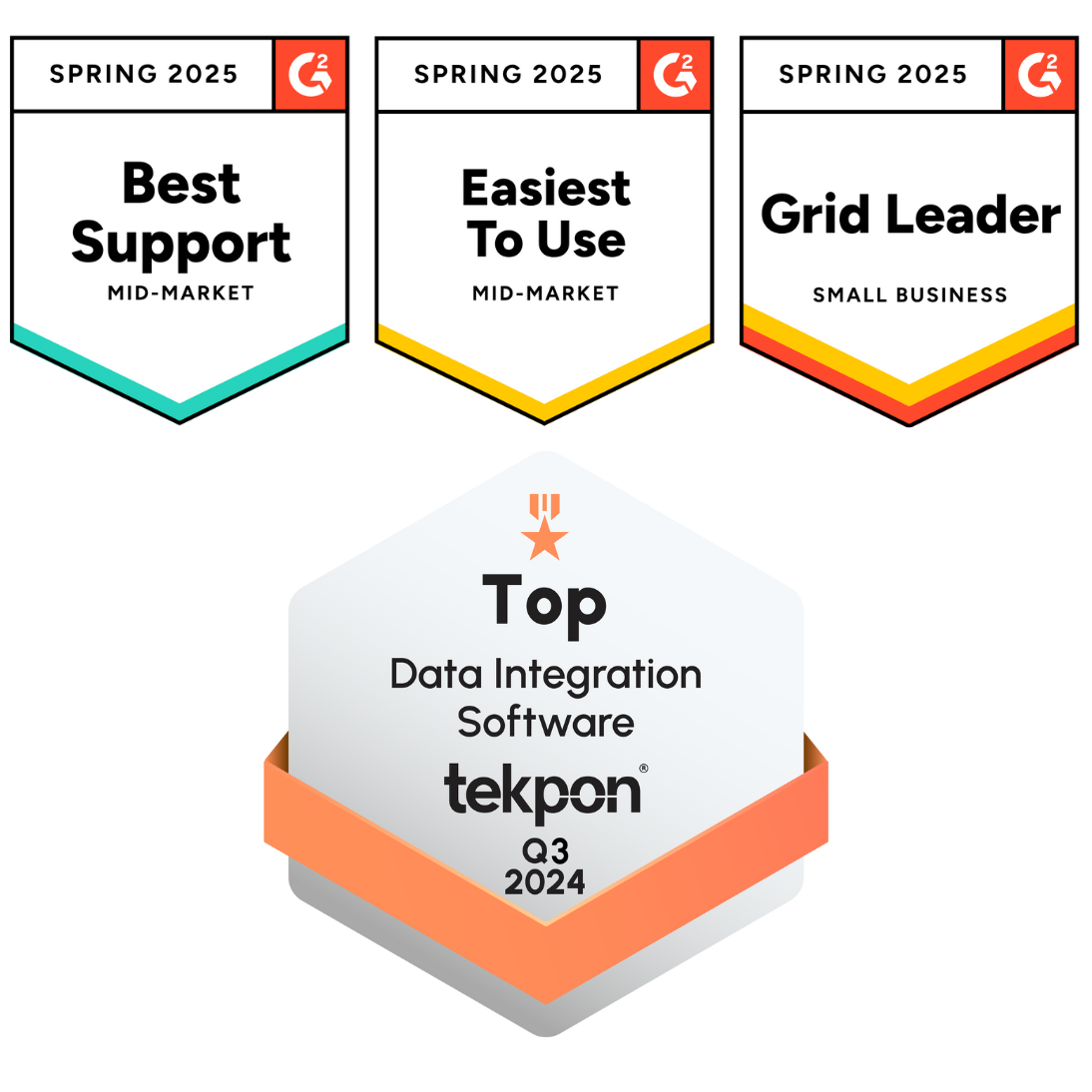The competitive advantages that come with integration no longer need explaining. Most business operations are already doing some from of updates between different applications, to ensure that data between them is aligned. Automating this data flow can save on hours of effort. Getting the integration approach right can ensure your business is set for the long term.
And for businesses that rely heavily on their ERP, this can be done via an ERP-first integration approach.
What is ERP-First Integration?
Simply put: ERP-First Integration turns your ERP into the central data hub for your entire business stack. It eliminates manual effort, human error, and ensures departments across your organization are all on the same page.
How It Works
Whether yours is a cloud-based ERP system or a legacy one, the ERP acts as the brain of your business operations. Placing it in the center of connecting other specialized tools ensures bidirectional data flow through this central hub, in a way that adapts to your business as it grows.

| Regular Connecting | ERP-First Integration |
| • Best for the quick-fixes • Not scalable • Costs may add up down the line | • Ideal for the long-term • Add or remove systems as the business scales • Cost efficiency from Day 1 |
Why Choose ERP-First Integration
Single Source of Truth
When your ERP is the central hub, all critical business data—financials, inventory, orders, customer information—flows through one authoritative system. This eliminates data silos and ensures everyone is working from the same accurate information, reducing errors from conflicting data across platforms.
Reduced Integration Complexity
Instead of creating a web of point-to-point connections between multiple systems, an ERP-first approach places the ERP at the core of your operations. You integrate each application once with the ERP rather than connecting every system to every other system, dramatically simplifying your integration architecture and making it easier to maintain.
Better Data Governance and Compliance
With the ERP as the central control point, you can enforce consistent data validation rules, security policies, and audit trails across all integrated systems. This is especially important for regulatory compliance (SOX, GDPR, industry-specific regulations) since you have one place to manage access controls and track data changes.
Scalability and Future-Proofing
As your business grows and you add new applications (CRM, ecommerce, warehouse management, etc.), an ERP-first architecture makes it easier to onboard new systems. Each new tool only needs to integrate with the ERP, not with every existing system, allowing you to scale your tech stack without exponential integration overhead.
Improved Operational Efficiency and Automation
An ERP-first approach enables end-to-end process automation across your organization. For example, a sales order in your CRM can automatically trigger inventory checks, procurement workflows, shipping notifications, and financial postings—all orchestrated through the ERP. This reduces manual data entry, speeds up processes, and minimizes errors.
Also see: ERP Integration Challenges Explained [+10 Solutions]
Getting Started With Your Integration Strategy
Here are the various steps you can expect to take on your way to integrate your tech-stack:
Step 1: Audit Your Current State
Map out all existing systems, applications, and current integration points. Identify where data lives, how it flows between systems, and where redundancies or gaps exist. Document pain points like manual data entry, sync issues, or conflicting data sources.
Step 2: Define Your Data Model and Governance
Establish the ERP as your master data source. Define which data entities (customers, products, orders, financials) will be owned by the ERP and create clear data governance policies. Set standards for data formats, validation rules, and how conflicts will be resolved when external systems try to update ERP data.
Step 3: Prioritize Integration Use Cases
Rank your integration needs based on business impact and complexity. Start with high-value, lower-risk integrations like syncing customer data from CRM to ERP, or pushing order data from e-commerce to ERP. Create a phased roadmap rather than trying to integrate everything at once.
Step 4: Choose Your Integration Platform/Middleware
Select integration tools that support your ERP platform. For example, DCKAP Integrator — the ERP-integration platform — syncs all tools preferred by distributors and manufacturers.. Ensure the platform can handle real-time and batch integrations, error handling, and monitoring.
Step 5: Build and Test Core Integrations
Develop your priority integrations using the hub-and-spoke model with the ERP at the center. Start with one-way data flows before implementing bi-directional syncs. Thoroughly test in a sandbox environment, focusing on data accuracy, error handling, and edge cases.
Step 6: Implement Monitoring and Maintenance Protocols
Set up real-time monitoring dashboards to track integration health, data flow volumes, and error rates. Create alerts for failures and establish clear procedures for troubleshooting. Document all integrations and assign ownership for ongoing maintenance. If you are a DCKAP client, you can leave several of these steps to us.
Step 7: Train Teams and Iterate
Train relevant teams on how the integrated system works, where data originates, and what to do when issues arise. Gather feedback on performance and pain points, then continuously optimize your integrations based on real-world usage and changing business needs.
At DCKAP, we ensure that clients who’d like to offload many of these steps, can do so unto our team of integration experts.
DCKAP Integrator: The ERP-First Integration Platform
There are many reasons why distributors and manufacturers choose DCKAP Integrator, including:
ERP-First Integration Approach
DCKAP Integrator is the ERP-first Integration Platform specifically built for distributors and manufacturers. It’s not trying to be everything to everyone. It is designed to solve integration problems and focus on what matters most to distribution businesses. It connects distribution ERPs like Epicor, Sage, Tribute, Turn, NetSuite, Dynamics 365, Infor, and Distribution One, with platforms like Adobe Commerce, BigCommerce, Shopify, and CRMs like Salesforce and HubSpot, backed by years of expertise in this niche.
World-Class Support
The DCKAP team helps through multiple rounds of tweaking and testing until everything works perfectly, taking the time to truly understand each ERP platform’s unique requirements. Especially for clients who have other business priorities for their in-house teams, DCKAP’s integration engineers can handle everything from building the data pipelines, to maintaining them. The team doesn’t just set it up and disappear, they partner with customers for the long-run.
Power Without the Complexity
DCKAP’s simple, low-code interface uses drag-and-drop functionality—no technical expertise required. Businesses can set up automated, bi-directional transfers that work in real-time or on schedule, with unlimited data syncing. Track everything in real-time with robust analytics, and when something goes wrong, built-in debugging makes fixes straightforward.
EDI Functionality
DCKAP also offers a means for distributors and manufacturers to stay on top of all trading partner exchanges with its EDI offering. Allowing for both EDI transactions, and syncing EDI data to the ERP, it ensures that businesses can foster timely document exchanges across multiple partners.
Next Steps
If you’re looking for an integration solution that is built to grow with your business, adapt to it’s roadmap, and help across departments, opt for an ERP-first approach to your integration.
And if you’re a distributor or manufacturer looking for an ERP-first solution that truly understands your needs, look no further than the DCKAP Integrator.
Want to learn more? Speak to our integration experts today about your integration needs.
FAQs
How does ERP-first integration differ from other middleware approaches?
Traditional middleware often treats all systems as equals, creating a complex web of point-to-point connections where data can exist in multiple places with no clear “source of truth.” ERP-first integration positions the ERP as the central hub and single source of truth, with all other systems connecting to it in a hub-and-spoke model. This means fewer integration points to manage, clearer data governance, and simpler troubleshooting since everything flows through one authoritative system rather than bouncing between multiple platforms.
Can the platform handle industry-specific ERPs?
Yes, DCKAP Integrator connects with distribution-focused ERPs including Epicor, Oracle NetSuite, Microsoft Dynamics 365, Distribution One, Infor, and Sage. The platform is specifically designed for the manufacturing and distribution industries, so it understands the unique requirements of these specialized ERP systems: from complex pricing structures and inventory management to industry-specific workflows that generic integration platforms often struggle with.
What are the advantages of using DCKAP Integrator versus building custom middleware internally?
Building custom middleware internally requires significant development resources, ongoing maintenance, extensive testing, and deep expertise in multiple systems, all of which diverts your tech team from core business initiatives. DCKAP Integrator dramatically reduces implementation time and has a team of hands-on experts to handle it for you. You also get proven reliability, expert support that understands distribution challenges, and zero maintenance demands.





